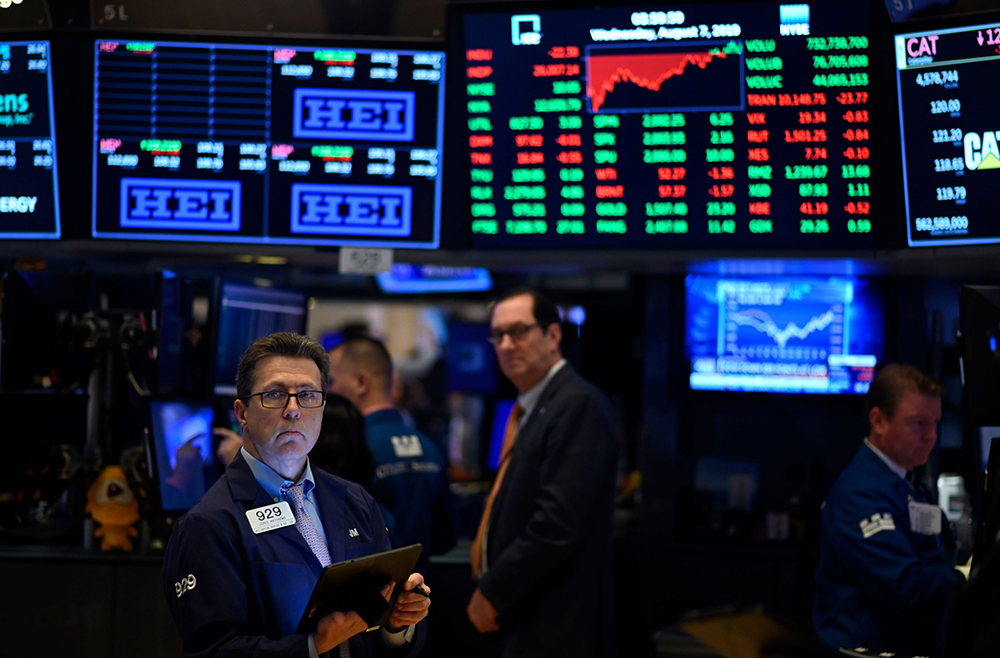
投資者們有合理的理由對(duì)美國(guó)經(jīng)濟(jì)尚未出問(wèn)題感到驚訝:上一次美國(guó)政府債券收益率大幅快速上漲,,使美國(guó)陷入了連續(xù)的經(jīng)濟(jì)衰退,。
過(guò)去三年,10年期國(guó)債收益率上漲了超過(guò)整整四個(gè)百分點(diǎn),,本周一度突破了5%,,這是自2007年以來(lái)的首次。10年期國(guó)債收益率是金融系統(tǒng)衡量資金成本的關(guān)鍵基準(zhǔn)指標(biāo),。上世紀(jì)80年代初,,10年期國(guó)債收益率大幅上漲,當(dāng)時(shí)保羅·沃克為應(yīng)對(duì)通脹所做的努力,,使10年期國(guó)債收益率暴漲至近16%?,F(xiàn)在,10年期國(guó)債收益率創(chuàng)下在那之后的最大漲幅,。
在某種意義上,,這種相似性并不意外,因?yàn)槊缆?lián)儲(chǔ)主席杰羅姆·鮑威爾采取了自那之后最激進(jìn)的加息,。另一方面,,它也強(qiáng)調(diào)了時(shí)代已經(jīng)不同。
上世紀(jì)80年代,,激進(jìn)的貨幣政策引發(fā)了兩次經(jīng)濟(jì)衰退?,F(xiàn)在經(jīng)濟(jì)的表現(xiàn)依舊超出了許多人的悲觀預(yù)測(cè),亞特蘭大聯(lián)儲(chǔ)(Atlanta Fed)的估計(jì)顯示,,第三季度,,美國(guó)經(jīng)濟(jì)將更加強(qiáng)勁。
當(dāng)然,,在沃克主持美聯(lián)儲(chǔ)期間,,采取了更緊縮的貨幣政策。彭博社匯總的數(shù)據(jù)顯示,,從1981年年中開始,,到美國(guó)陷入第二次經(jīng)濟(jì)衰退的時(shí)候,針對(duì)消費(fèi)物價(jià)上漲調(diào)整后的“實(shí)際”10年期國(guó)債收益率(扣除通脹后的收益率)約為4%。現(xiàn)在約為1%,。
但經(jīng)濟(jì)出人意料地強(qiáng)勁增長(zhǎng),,卻加劇了市場(chǎng)的不確定性。過(guò)去幾個(gè)月債券收益率大幅上漲,,而且有越來(lái)越多人相信美聯(lián)儲(chǔ)會(huì)繼續(xù)維持高利率,。
這種經(jīng)濟(jì)韌性能否持久,仍有待觀察,。億萬(wàn)富翁投資者比爾·阿克曼周一平掉了做空長(zhǎng)期債券的空倉(cāng),,他表示美國(guó)經(jīng)濟(jì)正在快速放緩。
但在年初也有類似的觀點(diǎn),,還有人預(yù)測(cè)隨著美聯(lián)儲(chǔ)改變立場(chǎng),,債券市場(chǎng)將會(huì)反彈。
而實(shí)際上,,債券價(jià)格卻持續(xù)下跌,。彭博美國(guó)國(guó)債總體指數(shù)(Bloomberg US Treasury Total Index)今年下跌約2.6%,跌幅已從2020年8月的最高點(diǎn)擴(kuò)大至18%,。相比之下,,之前從最高點(diǎn)到最低點(diǎn)的最大跌幅是1980年的約7%。當(dāng)時(shí)美聯(lián)儲(chǔ)的關(guān)鍵基準(zhǔn)利率達(dá)到了20%,。當(dāng)前的跌幅之所以比以往更加嚴(yán)重,,是因?yàn)槔室恢陛^低,導(dǎo)致投資者沒(méi)有足夠的利息收入幫助抵消下跌帶來(lái)的影響,。
另外一個(gè)因素是,,聯(lián)邦赤字大幅增加,。當(dāng)傳統(tǒng)的主要買家,,包括美聯(lián)儲(chǔ)和其他主要央行,均減少購(gòu)買債券時(shí),,美國(guó)向市場(chǎng)發(fā)行了大量新國(guó)債,。這被認(rèn)為是最近幾周,當(dāng)期貨市場(chǎng)表明交易商預(yù)期美聯(lián)儲(chǔ)可能已經(jīng)停止加息時(shí),,國(guó)債收益率上漲的原因之一,。
摩根大通資產(chǎn)管理公司(JPMorgan Asset Management)的投資組合經(jīng)理普利亞·米斯拉表示:“我們的基準(zhǔn)情景是硬著陸,但我無(wú)法拿出任何數(shù)據(jù)說(shuō):‘這是明顯的經(jīng)濟(jì)衰退的先導(dǎo)指標(biāo),,要注意這個(gè)指標(biāo),。’”
她說(shuō)道:“投資者的信心水平較低,?!彼€表示,購(gòu)買債券的投資者”都受到了傷害“。(財(cái)富中文網(wǎng))
譯者:劉進(jìn)龍
審校:汪皓
投資者們有合理的理由對(duì)美國(guó)經(jīng)濟(jì)尚未出問(wèn)題感到驚訝:上一次美國(guó)政府債券收益率大幅快速上漲,,使美國(guó)陷入了連續(xù)的經(jīng)濟(jì)衰退,。
過(guò)去三年,10年期國(guó)債收益率上漲了超過(guò)整整四個(gè)百分點(diǎn),,本周一度突破了5%,,這是自2007年以來(lái)的首次。10年期國(guó)債收益率是金融系統(tǒng)衡量資金成本的關(guān)鍵基準(zhǔn)指標(biāo),。上世紀(jì)80年代初,,10年期國(guó)債收益率大幅上漲,當(dāng)時(shí)保羅·沃克為應(yīng)對(duì)通脹所做的努力,,使10年期國(guó)債收益率暴漲至近16%?,F(xiàn)在,10年期國(guó)債收益率創(chuàng)下在那之后的最大漲幅,。
在某種意義上,,這種相似性并不意外,因?yàn)槊缆?lián)儲(chǔ)主席杰羅姆·鮑威爾采取了自那之后最激進(jìn)的加息,。另一方面,,它也強(qiáng)調(diào)了時(shí)代已經(jīng)不同。
上世紀(jì)80年代,,激進(jìn)的貨幣政策引發(fā)了兩次經(jīng)濟(jì)衰退?,F(xiàn)在經(jīng)濟(jì)的表現(xiàn)依舊超出了許多人的悲觀預(yù)測(cè),亞特蘭大聯(lián)儲(chǔ)(Atlanta Fed)的估計(jì)顯示,,第三季度,,美國(guó)經(jīng)濟(jì)將更加強(qiáng)勁。
當(dāng)然,,在沃克主持美聯(lián)儲(chǔ)期間,,采取了更緊縮的貨幣政策。彭博社匯總的數(shù)據(jù)顯示,,從1981年年中開始,,到美國(guó)陷入第二次經(jīng)濟(jì)衰退的時(shí)候,針對(duì)消費(fèi)物價(jià)上漲調(diào)整后的“實(shí)際”10年期國(guó)債收益率(扣除通脹后的收益率)約為4%?,F(xiàn)在約為1%,。
但經(jīng)濟(jì)出人意料地強(qiáng)勁增長(zhǎng),卻加劇了市場(chǎng)的不確定性,。過(guò)去幾個(gè)月債券收益率大幅上漲,,而且有越來(lái)越多人相信美聯(lián)儲(chǔ)會(huì)繼續(xù)維持高利率。
這種經(jīng)濟(jì)韌性能否持久,,仍有待觀察,。億萬(wàn)富翁投資者比爾·阿克曼周一平掉了做空長(zhǎng)期債券的空倉(cāng),,他表示美國(guó)經(jīng)濟(jì)正在快速放緩。
但在年初也有類似的觀點(diǎn),,還有人預(yù)測(cè)隨著美聯(lián)儲(chǔ)改變立場(chǎng),,債券市場(chǎng)將會(huì)反彈。
而實(shí)際上,,債券價(jià)格卻持續(xù)下跌,。彭博美國(guó)國(guó)債總體指數(shù)(Bloomberg US Treasury Total Index)今年下跌約2.6%,跌幅已從2020年8月的最高點(diǎn)擴(kuò)大至18%,。相比之下,,之前從最高點(diǎn)到最低點(diǎn)的最大跌幅是1980年的約7%。當(dāng)時(shí)美聯(lián)儲(chǔ)的關(guān)鍵基準(zhǔn)利率達(dá)到了20%,。當(dāng)前的跌幅之所以比以往更加嚴(yán)重,,是因?yàn)槔室恢陛^低,導(dǎo)致投資者沒(méi)有足夠的利息收入幫助抵消下跌帶來(lái)的影響,。
另外一個(gè)因素是,,聯(lián)邦赤字大幅增加。當(dāng)傳統(tǒng)的主要買家,,包括美聯(lián)儲(chǔ)和其他主要央行,,均減少購(gòu)買債券時(shí),美國(guó)向市場(chǎng)發(fā)行了大量新國(guó)債,。這被認(rèn)為是最近幾周,,當(dāng)期貨市場(chǎng)表明交易商預(yù)期美聯(lián)儲(chǔ)可能已經(jīng)停止加息時(shí),國(guó)債收益率上漲的原因之一,。
摩根大通資產(chǎn)管理公司(JPMorgan Asset Management)的投資組合經(jīng)理普利亞·米斯拉表示:“我們的基準(zhǔn)情景是硬著陸,,但我無(wú)法拿出任何數(shù)據(jù)說(shuō):‘這是明顯的經(jīng)濟(jì)衰退的先導(dǎo)指標(biāo),要注意這個(gè)指標(biāo),?!?/p>
她說(shuō)道:“投資者的信心水平較低?!彼€表示,,購(gòu)買債券的投資者”都受到了傷害“,。(財(cái)富中文網(wǎng))
譯者:劉進(jìn)龍
審校:汪皓
There’s a good reason why investors are amazed that something hasn’t broken in the economy yet: The last time US government bond yields climbed so far, so fast, the nation plunged into back-to-back recessions.
The 10-year Treasury yield — a key baseline for the cost of money across the financial system — has jumped more than four full percentage points over the past three years, briefly pushing it this week over 5% for the first time since 2007. It’s the biggest increase since the run up in the early 1980s, when Paul Volcker’s efforts to slay inflation pushed the 10-year yield to nearly 16%.
In one sense, the similarities are no surprise, since Fed Chair Jerome Powell’s interest-rate hikes have been the most aggressive since then. In another, it underscores just how much times have changed.
In the 1980s, the monetary policy onslaught set off two recessions. Now, the economy has continued to defy pessimistic forecasts, with the Atlanta Fed’s estimate showing that in the third quarter it likely even gained steam.
Of course, policy was more restrictive during the Volcker era. Adjusted for consumer-price increases, the “real” 10-year Treasury yield — or what it paid after inflation — was around 4% by the time the second downturn of the period started in mid-1981, according to data compiled by Bloomberg. It’s around 1% now.
But the surprising economic strength has nevertheless injected large amounts of uncertainty into markets, where bond yields have pushed up sharply over the past several months amid increasing conviction that the Fed will keep interest rates high.
Whether such resilience can be sustained remains to be seen. Billionaire investor Bill Ackman closed his bearish bets against long-term bonds Monday, saying the economy is slowing fast.
Yet the year began with similar calls, accompanied by expectations that the bond market would rally as the Fed changed course.
Instead, bond prices have kept tumbling. The Bloomberg US Treasury Total Index is down about 2.6% this year, extending its losses since the peak in August 2020 to 18%. In comparison, the worst peak-to-trough drawdown previously was a decline of about 7% in 1980, when the Fed’s key benchmark hit 20%. This selloff has been more painful because rates had been low, depressing the income payments that help to offset the hit.
Another factor has been the sharp increase in the federal deficit, which is flooding the market with new Treasuries at a time when traditional big buyers, including the Fed and other major central banks, have pulled back on bond buying. That’s seen as one reason why yields have marched higher in recent weeks even as the futures market shows traders think the Fed’s rate hikes are likely done.
“A hard landing is sort of our base case scenario — but I can’t point to any data and say, ‘This is a clear leading indicator of a recession and look right here,’”said Priya Misra, a portfolio manager at JPMorgan Asset Management
“Conviction levels are low,” she said. Investors who had been buying bonds “have all been hurt,” she said.






